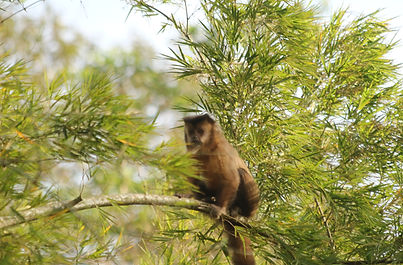
My main research interests are primate behaviour, ecological requirements and how they adapt to anthropogenic habitat changes. I believe that conservation strategies should be based in in a foundation of strong research and that research scientists have a responsibility to apply their results in a way that benefits local communities and stakeholders.
The Ecological Requirements of the Hooded Capuchin in the Paraguayan Upper Paraná Atlantic Forest.


This project has been running since January 2013 and has focused on three groups of hooded capuchin (Sapajus cay) at two sites in the remnants of the Upper Paraná Atlantic Forest. From January 2013 - May 2017 I studied two groups in Rancho Laguna Blanca, San Pedro, Paraguay. These groups lived in a 243ha patch of highly degraded forest, isolated by soy fields and human settlements. From May 2017 - present I study one group in Nueva Gambach, a 150ha property at the southern tip of San Rafael in Itapúa.
This aim of this project is to determine the adaptability of the capuchins to anthropogenic habitat change. Only around 9% of the Paraguayan Atlantic Forest remains as the majority has been destroyed by the advance of industrial agriculture. The results of this project will be used to create a conservation action plan for the remaining Atlantic Forest, using the capuchin as a flagship species to gain public support.


The Urban Black-&-Gold Howler Monkeys of Pilar, Paraguay.


This project began in May 2017 when Para La Tierra moved to Pilar, Ñeembucú in southwest Paraguay. Pilar is unusual in that it is home to a large population of black-&-gold howler monkeys (Alouatta caraya) living inside the city. This project aims to study all aspects of these unique monkeys behaviour and ecology in comparison to those living in the Ñeembucú Wetland Complex - the naturally mosaic habitat that surrounds the city - and understand how living in such a highly anthropogenic environment impacts them.
Students from around the world have carried out studies examining the monkeys social behaviour, gastrointestinal parasite loads, home ranges, diet and vocalisations. If you would like to carry out your own research with this project (or send undergraduate or graduate students to work with us) please visit www.paralatierra.org.


Medium-Large Mammal Presence and Abundance in Areá para Parque San Rafael
Beginning in late 2021 this project will used an intensive camera trap survey of the southern most properties of Areá para Parque San Rafael to monitor the presence and abundance of medium-large mammal fauna in the area. These results will be combined with locational data from the capuchin research project to understand inter-specific interactions between the monkeys and other mammalian species in the forest.